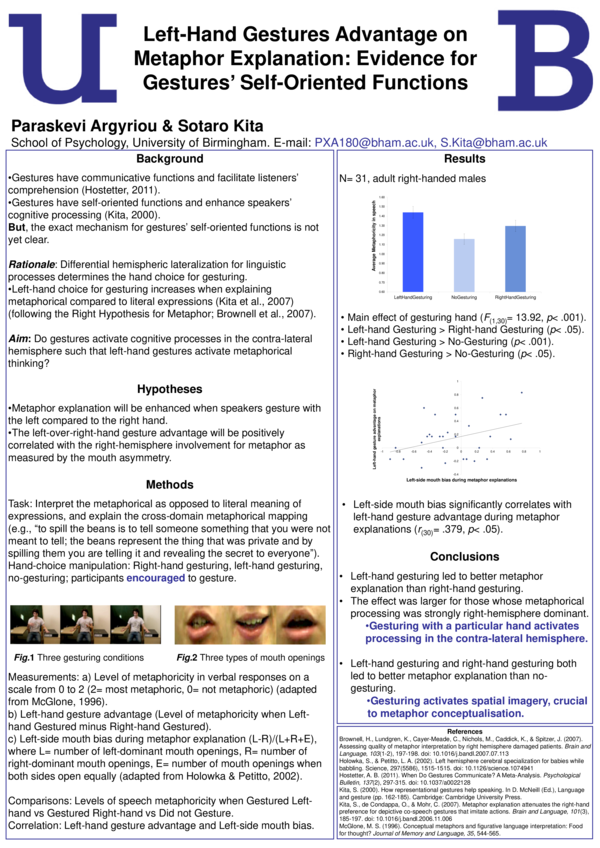Academia.edu no longer supports Internet Explorer.
To browse Academia.edu and the wider internet faster and more securely, please take a few seconds to upgrade your browser.
Left-Hand Gestures Advantage on Metaphor Explanation: Evidence for Gestures’ Self-Oriented Functions
Left-Hand Gestures Advantage on Metaphor Explanation: Evidence for Gestures’ Self-Oriented Functions
Related Papers
Brain and Language
Metaphor explanation attenuates the right-hand preference for depictive co-speech gestures that imitate actions2007 •
2014 •
The in-house conference presents an excellent cross-section of current research conducted at the Department of Psychology. There are 4 talk sessions, 1 poster session, lunch and pizza! Each talk will last 12 minutes with 3 minutes for questions. We look forward to hearing about the exciting work that is going on in the department. We hope that you find time to take in as many talks and posters as you can. And, we hope that you stay around after the final talk for food and drinks. Schedule of Events
Language and Cognitive Processes
Being someone's right hand doesn't always feel right: bodily experiences affect metaphoric language processing2013 •
Journal of Experimental Psychology: General
Embodiment of Abstract Concepts: Good and Bad In Right-and Left-Handers.2009 •
Frontiers in Human Neuroscience
Body-specific motor imagery of hand actions: neural evidence from right- and left-handers2009 •
Brain and Language
Understanding metaphors: Is the right hemisphere uniquely involved?2007 •
Two divided visual field priming experiments examined cerebral asymmetries for understanding metaphors varying in sentence constraint. Experiment 1 investigated ambiguous words (e.g., SWEET and BRIGHT) with literal and metaphoric meanings in ambiguous and unambiguous sentence contexts, while Experiment 2 involved standard metaphors (e.g., The drink you gave me was a meteor) with sententially consistent and inconsistent targets (i.e., POTENT vs COMET). Similar literal and metaphor priming effects were found in both visual fields across most experimental conditions. However, RH processes also maintained activation of sententially inconsistent literal meanings following metaphoric expressions. These results do not strongly support the RH as the preferred substrate for metaphor comprehension (e.g., ), and suggest that processes in both hemispheres can support metaphor comprehension, although not via identical mechanisms. The LH may utilize sentence constraint to select and integrate only contextually relevant literal and metaphoric meanings, whereas the RH may be less sensitive to sentence context and can maintain the activation of some alternative interpretations. This may be potentially useful in situations where an initial understanding must be revised.
RELATED PAPERS
Diálogos Mediterrânicos
"O ATLÂNTICO NORTE ANTIGO E MEDIEVAL – DIÁLOGOS E CONEXÕES"2023 •
Journal of Consulting and Clinical Psychology
Early family environments and traumatic experiences associated with borderline personality disorder1993 •
2020 •
Nonlinear Analysis: Hybrid Systems
SimHPN: A MATLAB toolbox for simulation, analysis and design with hybrid Petri nets2012 •
Bulletin of University of Agricultural Sciences and Veterinary Medicine Cluj-Napoca. Animal Science and Biotechnologies
The Distribution of Fresh Matter Yields in Some Mixtures of Perennial Grasses and Legumes2011 •
American Studies
“White Trash” in Literary History: The Social Interventions of Erskine Caldwell and James Agee2014 •
Journal of the Society of Mechanical Engineers
Systematization of Knowledge in Expert Systems : From the Experience of WELCON Development(Safety and Reliability in Mechanical Engineering -Philosophy and Technology)1987 •
2004 IEEE International Symposium on Circuits and Systems (IEEE Cat. No.04CH37512)
Sampled analog architecture for DCT and DSTJournal of Feline Medicine and Surgery
Veterinary services during the COVID-19 pandemic: less stressful for cats and their carers?2022 •
The Journal of Physical Chemistry C
Photochemically Induced Circular Dichroism of Semiconductor Quantum Dots2019 •

 Paraskevi Argyriou
Paraskevi Argyriou